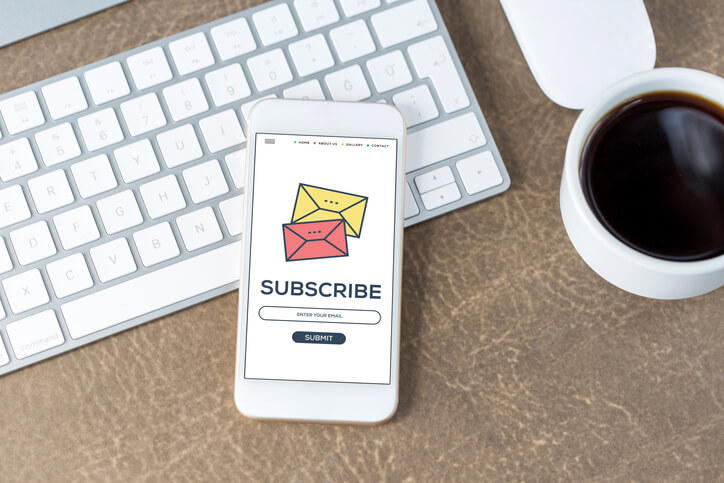Email marketing remains one of the most cost-effective ways to engage with customers and generate a strong return on investment (ROI). When done right, it can boost your brand’s visibility and drive a significant ROI.
Check out these incredible stats on the power of email marketing:
- The average expected ROI is $42 for every $1 you spend on email marketing.
- 18% of companies achieve email marketing ROI greater than $70 per $1 invested.
- A survey from eMarketer reveals that email marketing drives 25% of the overall revenues from those companies surveyed.
- Consumers who purchase products through email spend 138% more than those that don’t receive email offers.
- Marketers listed email marketing as the most effective marketing strategy, followed by Paid Search/Ads, Organic Search, Social Media, and Events. 79% of marketers included email within their top three marketing channels.
- Email marketing persuades the purchasing decisions of nearly 6 out of every 10 email subscribers. At least once per month, 50.7% buy something from a marketing email. Meanwhile, 23.8% of people make a purchase via marketing emails several times per month and 3% do it more than once per week!
- Email is 40x more effective than social media for customer acquisition.
- 4.24% of email traffic leads to purchases, whereas only 2.49% of search traffic and 0.59% of social traffic does the same.
- In a Statista report, 73% of Company respondents and 75% of Agency respondents rated email marketing as an excellent digital marketing channel for ROI.
- 59% of respondents say marketing emails influence their purchase decisions and 80% of business professionals believe that email marketing increases customer retention.
5 Ways Optimize Your Email Campaigns
However, to truly maximize ROI, it’s important to approach email marketing with a strategic mindset. Here’s 5 ways to optimize your email campaigns.

1. Segment Your Audience for Targeted Messaging
One-size-fits-all email campaigns are a thing of the past. Segmenting your audience allows you to tailor your messages to specific groups based on their behavior, preferences, and demographics.
Segmented emails drive 30% more opens and 50% more clicksthroughs than unsegmented ones.
Segmentation can be as simple or as complex as your data allows. The key is to start with meaningful segments that align with your business goals and gradually refine them as you gather more data.
Here are some effective ways to segment your audience:
- Demographic Segmentation: This includes basic information such as age, gender, income level, and education. For example, if you’re a retailer, you might create segments based on gender to send targeted promotions for men’s or women’s products.
- Behavioral Segmentation: This involves dividing your audience based on their actions, such as purchase history, browsing behavior, or engagement with previous emails. For instance, you can target customers who have abandoned their carts with a reminder email that includes a special discount.
- Geographic Segmentation: If your business operates in multiple locations, consider segmenting your list based on geographic location. This allows you to send location-specific offers or information that is relevant to each recipient.
- Psychographic Segmentation: This goes a step further by considering the lifestyle, values, and interests of your audience. For example, a fitness brand might segment their audience based on whether they are interested in weight loss, muscle building, or general wellness.
- Lifecycle Stage Segmentation: Customers go through different stages in their journey with your brand, from awareness to consideration to purchase. Segmenting by lifecycle stage allows you to send appropriate content at each stage, such as welcome emails for new subscribers, product recommendations for potential buyers, or re-engagement emails for lapsed customers.
2. Focus on Creating Strong Subject Lines
The subject line is the first thing your recipients see, and it often determines whether your email will be opened or ignored.
Stats on the power of email subject lines:
- 47% of email recipients will open an email based on the subject line alone.
- 69% of email recipients will report spam based on the subject line.
- Urgent subject lines increase the open rate by an average of 22%.
- Emails with the recipient’s name in the subject line have an 18.30% open rate.
- Those that do not have names in the subject line only have a 15.70% open rate.
Check out these tips for writing strong subject lines:
- Aim for subject lines that are 50 characters or less. Shorter subject lines are more likely to display fully on mobile devices and in inbox previews. They also make it easier for recipients to quickly understand the email’s purpose.
- Using time-sensitive language can prompt recipients to act quickly. Phrases like “Limited Time Offer,” “Act Now,” or “Only 24 Hours Left” can encourage immediate engagement. However, use urgency sparingly to avoid overwhelming your audience.
- Clarity is key. Your subject line should clearly convey what the email is about. Avoid being too vague or cryptic, as this can lead to lower open rates. If the email contains a special offer, event, or important update, make that clear upfront.
- Personalization can make your emails feel more relevant to the recipient. Use the recipient’s name, location, or past purchase behavior in the subject line. For example, “John, Here’s a Special Offer Just for You” or “Exclusive Deals in [City Name].”
- Encourage your recipients to take action by using strong, action-oriented verbs. Words like “Get,” “Discover,” “Unlock,” and “Join” can create a sense of excitement and movement, prompting the reader to open the email.
- A light-hearted or humorous subject line can make your email stand out and create a positive association with your brand. For example, “Oops, Did We Just Make the Best Coffee Ever?” or “Get Ready to Fall in Love with Your Inbox.”
- Emojis can add a visual element to your subject line, making it more eye-catching in a crowded inbox. However, use emojis in moderation and ensure they align with your brand voice.
- Regularly A/B test different subject lines to see what resonates most with your audience. Test different lengths, tones, and formats to determine what drives the highest open rates. Use the data to continually refine your subject line strategy.
3. Leverage Email Automation
Email automation allows you to send targeted emails at the right time without the need for manual intervention.
5 types of automated emails to consider include:
- Welcome Emails: When someone subscribes to your newsletter or signs up for an account, a welcome email is often the first point of contact. Automated welcome emails can introduce your brand, highlight key features or products, and provide a special offer to encourage immediate engagement. This sets the tone for the relationship and helps to establish a strong first impression.
- Transactional Emails: Transactional emails, such as order confirmations, shipping notifications, and receipts, are essential for keeping customers informed about their purchases. These emails can be automated to ensure timely delivery, and they often have high open rates because they contain important information. You can also use these emails to upsell or cross-sell related products.
- Abandoned Cart Emails: Abandoned cart emails are triggered when a customer adds items to their cart but doesn’t complete the purchase. These automated reminders can include images of the products left behind, a special discount code, or a sense of urgency to encourage the customer to complete their purchase. This type of email can significantly increase your conversion rate by recovering potentially lost sales.
- Re-Engagement Emails: Over time, some subscribers may become inactive, opening your emails less frequently or not at all. Re-engagement emails are designed to win back these inactive subscribers. Automated workflows can detect inactivity and trigger a series of emails aimed at reigniting interest, such as offering a special discount, asking for feedback, or highlighting new products or services.
- Birthday or Anniversary Emails: Celebrating your customers’ milestones, such as their birthday or the anniversary of their first purchase, can strengthen your relationship with them. Automated birthday emails often include a special offer or personalized message, making the customer feel valued and appreciated.
4. Ensure Compliance with Privacy Regulations
Adhering to email marketing laws and regulations, such as GDPR and CAN-SPAM, is essential not only to avoid penalties but also to build trust with your audience. Ensure that your email list is composed of opt-in subscribers, include clear unsubscribe options in your emails, and be transparent about how you use customer data.
Customers are increasingly willing to share their data in exchange for personalized experiences. With 83% expressing a positive attitude towards data sharing, businesses have a valuable opportunity to enhance their email campaigns by leveraging customer insights to create more targeted and meaningful interactions.
5. Monitor and Clean Your Email List
Over time, email lists can become cluttered with inactive subscribers. Regularly monitor your list to identify and remove contacts who haven’t engaged with your emails in a while.
Start by identifying inactive subscribers—those who haven’t opened or clicked on any of your emails within a specific timeframe, such as the last 6-12 months. Once identified, you can attempt to re-engage these contacts with a targeted re-engagement campaign, offering special incentives or asking for feedback to rekindle their interest. If they remain unresponsive, consider removing them from your list to maintain its quality.
Additionally, regularly check for and remove invalid or incorrect email addresses, which can accumulate over time and negatively impact your deliverability. Implementing a double opt-in process for new subscribers can also help ensure that your list is composed of genuinely interested individuals from the start.
Conclusion
Email marketing can be a powerful tool for driving a strong ROI. By segmenting your audience, crafting compelling content, optimizing for mobile, leveraging automation, and continuously testing and refining your strategies, you can create email campaigns that not only engage your audience but also deliver significant returns. Remember, the key to success lies in understanding your audience and delivering value through every email you send.




